The Best Glazed Cranberry Orange Bread
This ultra-moist glazed cranberry orange bread has bright citrus flavor, a tender crumb, and cranberries that don’t sink. It’s perfect!
Cranberry and orange together are one of my favorite holiday flavor combinations, and this bread is absolutely incredible. Everything about it – from the glaze to the cranberries – is absolute perfection.
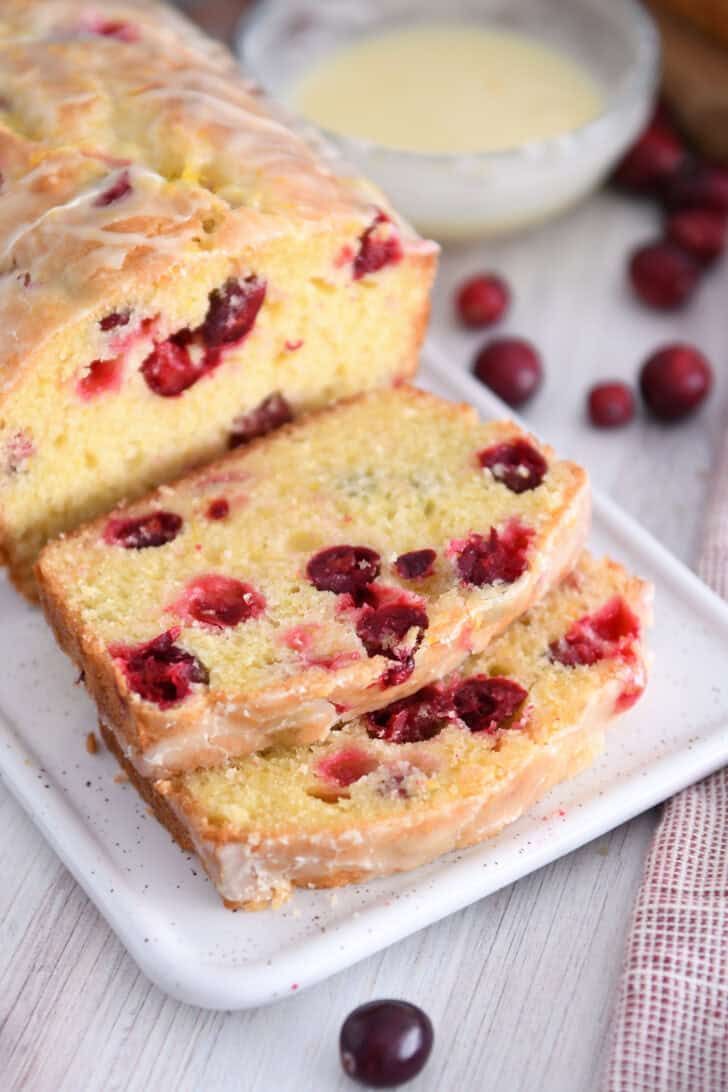
Why I Think You’ll Love This Bread
With millions of versions of this bread out there already, why does the world need another recipe?
The answer is simple: after lots of tweaking and testing, this version is better than any other recipe I’ve ever tried with more pronounced citrus flavor and a decidedly more moist and tender texture!
Here are a few more reasons to love this cranberry orange bread:
- The recipe can be made in one standard (8 1/2X4 1/2-inch) loaf pan or three mini loaf pans.
- It can easily be doubled.
- The bread stays moist for several days.
- If you follow all the tips in the recipe, the cranberries don’t sink! They are evenly distributed throughout the batter creating the most stunning slices.
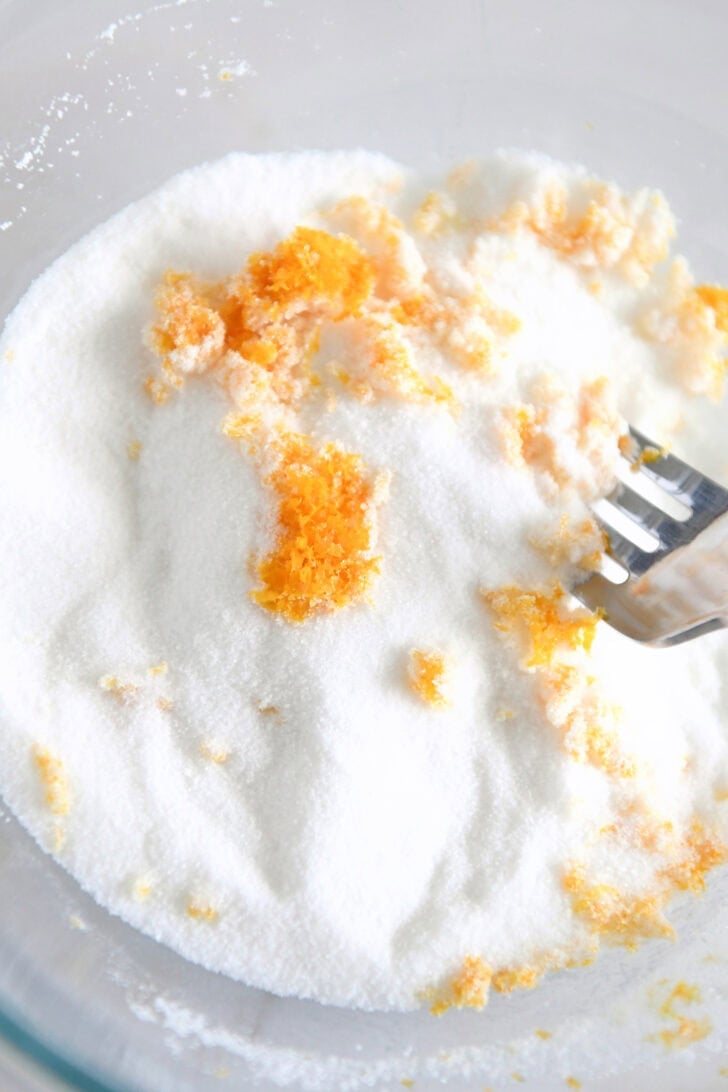
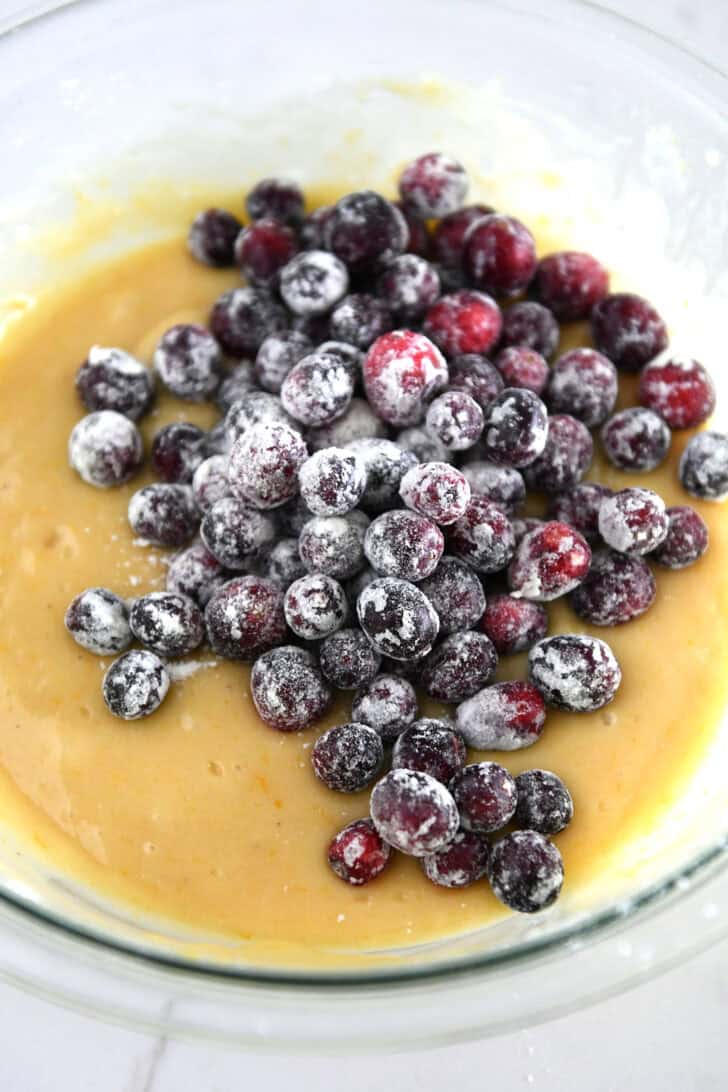
Key Ingredients for Cranberry Orange Bread
- Orange Zest: Fresh orange zest is an important ingredient in this recipe! You’ll need 1 full tablespoon zest (from about 1 large orange) for the batter and another 1 to 2 teaspoons zest in the glaze.
- Granulated Sugar: For the batter, the fresh orange zest is rubbed into the granulated sugar before mixing the rest of the ingredients. This releases the natural oils in the zest creating more delicious orange flavor. Don’t skip this step!
- Orange Juice: Since fresh oranges are needed for the zest, it makes sense to use the fresh orange juice from the oranges in the recipe. However, if for some reason that doesn’t work, you can use bottled orange juice instead.
- Cranberries: This recipe is best with fresh cranberries. It hasn’t been tested with dried cranberries. However, it should work fine with frozen cranberries.
- Buttermilk: Using buttermilk produces a more tender, more moist bread. I tested variations of this bread with varying amounts of milk, and using store bought buttermilk had the best results by far. Homemade buttermilk might also work. If making homemade buttermilk, I recommend using 2% or whole milk.
- All-Purpose Flour: I use unbleached, all-purpose flour. I suspect this bread might work fine with gluten-free flour. A reader recently commented that when subbing in gluten-free flour for all-purpose flour, they use 10% less flour (by weight) than the recipe calls for and results in baked goods are always fantastic.
🍊 Heads up: You’ll need two large oranges for this recipe. 🍊
Several other standard baking ingredients are also used, like eggs, baking powder, baking soda, and powdered sugar.
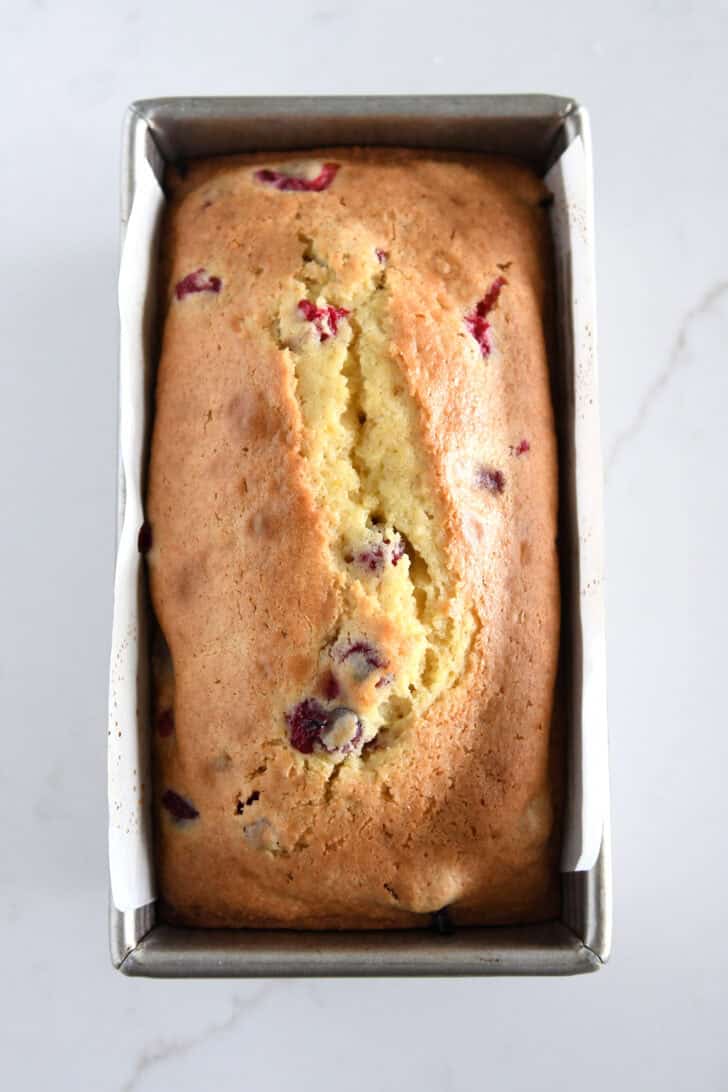
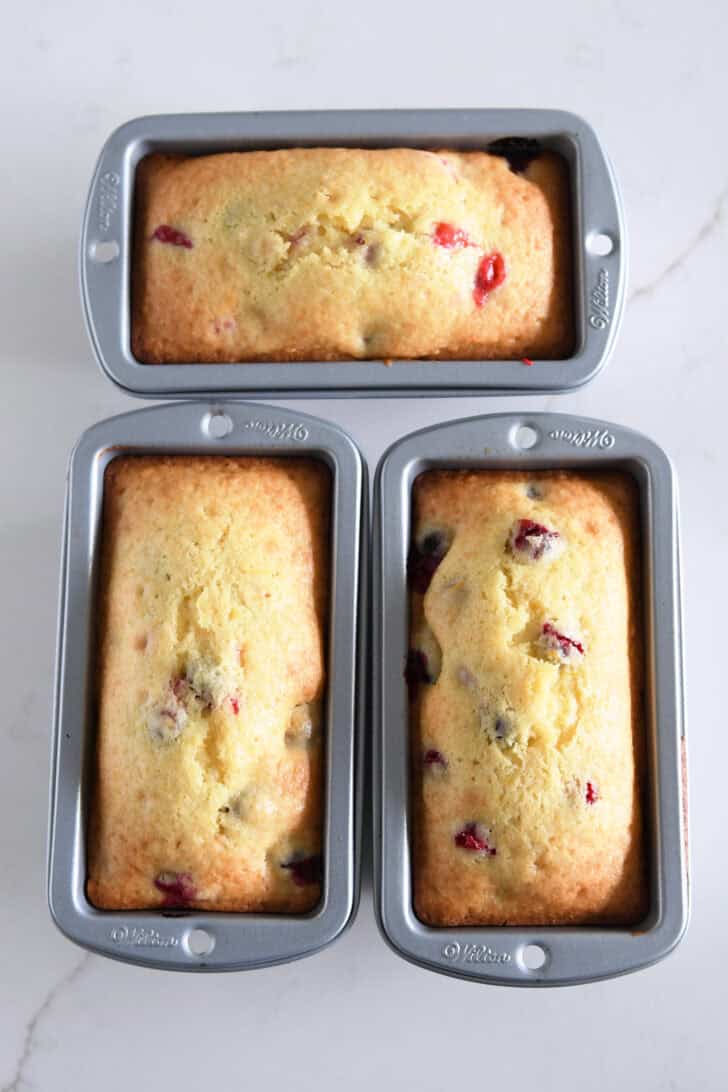
Tips for Making Cranberry Orange Bread
Make sure to read through the recipe in its entirety before making this bread, because there are some helpful tips (and options) that will ensure perfect cranberry orange bread.
Let me share a few tips about the glaze, in particular:
- You can make the glaze thin or thick, simply add more or less orange juice depending on the desired consistency. A thinner glaze will soak into the bread a bit more, whereas a thicker glaze will settle on top and form more of a sugary crust.
- The pictures below show the glaze made according to the thicker option. After a lot of test batches, I prefer making it on the thinner side so it soaks into the top of the bread just slightly. Either way is delicious.
- I made a delicious test batch using orange zest and lemon juice in the glaze (because I ran out of orange juice!). Wow, it was really good! The bread had a brighter, more tart flavor at first bite than using orange juice.
- The bread can be glazed right out of the oven (while still in the pan) if you want the glaze to soak almost completely into the bread. Or the bread can be removed to a cooling rack and the glaze can be drizzled across the top once the bread has cooled (or when it is still slightly warm).
So…you definitely have options when it comes to the glaze! Play around with how to make it and when to add it and see what you like the best!
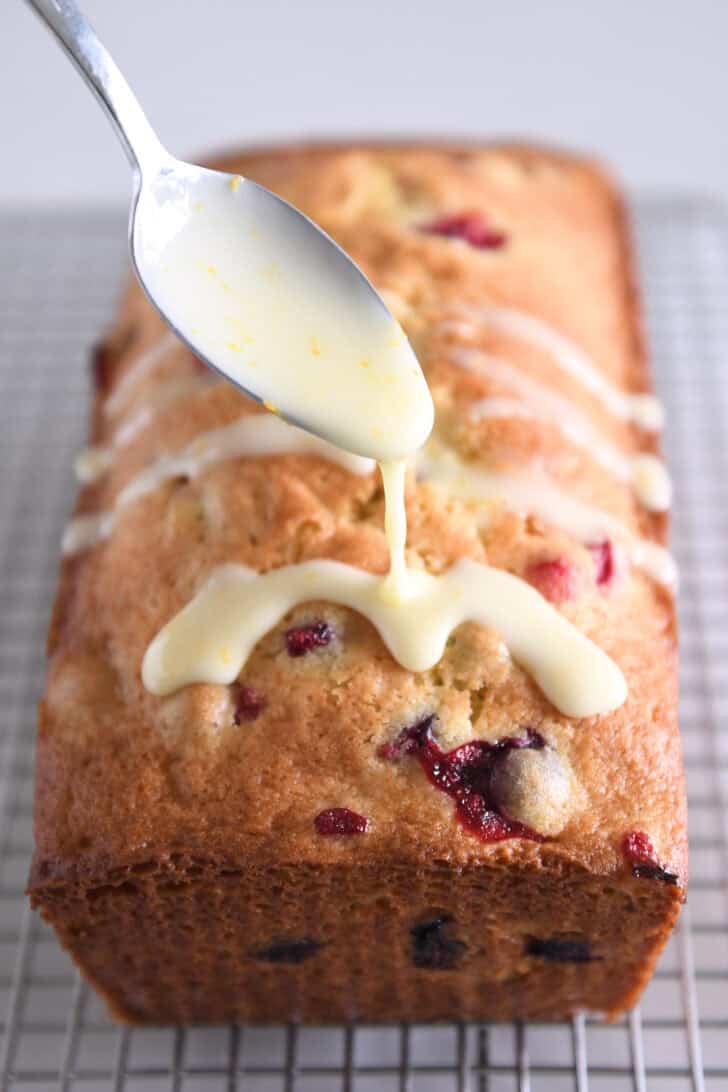
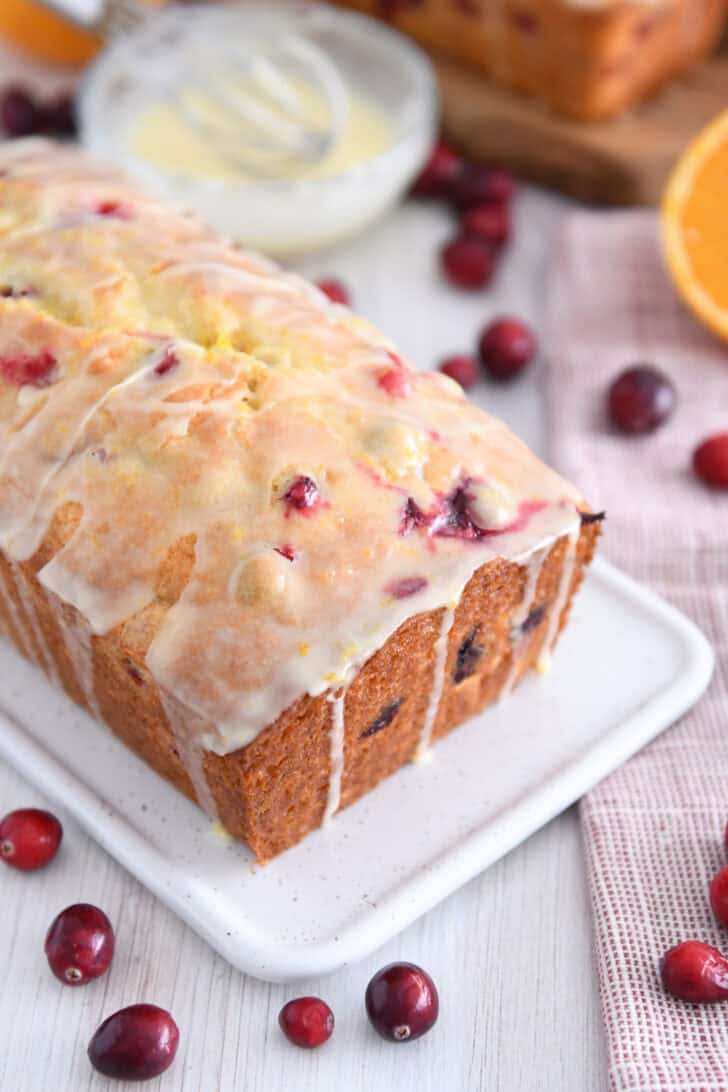
A Favorite Holiday Bread
This glazed cranberry orange bread is absolutely phenomenal. It has skyrocketed to the top of my holiday favorite baked goods list.
The bread is sweet without being cake-like sweet, and the cranberries pop with tart juiciness and flavor. The hint of orange in the bread batter and the glaze adds a flavor dimension that is just so good.
I can’t wait for you to make this bread! The flavors define all that is delicious and sweet about the holidays.
Make-Ahead Note: The glazed and cooled bread can be frozen for several months. Keep in mind that after thawing, the top of the bread may soften quite a bit (and may even have a bit of a soggy texture thanks to the glaze). An alternative is to freeze the bread unglazed and glaze after thawing.

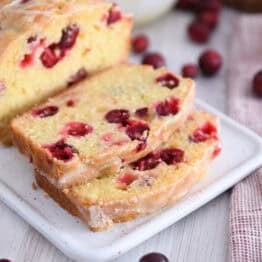
Glazed Cranberry Orange Bread
Ingredients
Bread:
- ¾ cup (160 g) granulated sugar
- 1 tablespoon fresh orange zest
- ½ cup (134 g) buttermilk (see note)
- ½ cup (100 g) neutral-flavored oil, like canola, vegetable, or grapeseed
- ¼ cup (55 g) orange juice
- 2 large (100 g) eggs
- 1 ½ cups (213 g) all-purpose flour
- 1 teaspoon baking powder
- ½ teaspoon salt
- ¼ teaspoon baking soda
- 1 ¼ cups (125 g) fresh cranberries
- 2 teaspoons all-purpose flour
Glaze:
- ¾ cup (86 g) powdered sugar
- 1 to 2 teaspoons fresh orange zest
- 1 to 2 tablespoons orange juice (see note)
Instructions
- Preheat oven to 350 degrees F. Lightly grease an 8 1/2 X 4 1/2-inch loaf pan or three mini loaf pans. If using a glass pan or dark-coated pan, reduce the oven temperature to 325 degrees F.
- For the bread, in a large bowl, add the granulated sugar and orange zest. Rub the zest into the sugar with your fingers until well-combined and fragrant.
- To the sugar mixture, add the buttermilk, oil, orange juice, and eggs. Whisk until well-combined.
- Add the flour, baking powder, salt, and baking soda. Whisk until JUST combined. It's ok if there are a few lumps and small dry streaks.
- In a small bowl, add the cranberries and spritz VERY lightly with water. I run my fingers quickly under water and then flick them over the cranberries. Add the 2 teaspoons flour and toss until the cranberries are lightly coated in flour.
- Add the cranberries to the batter and stir until evenly combined. Don't over mix.
- Pour the batter into the prepared pan(s). For a standard loaf pan, bake for 55 to 60 minutes. For mini loaf pans, bake for 28 to 30 minutes. Bake until the top of the bread springs back lightly to the touch and a toothpick inserted in the center comes out clean or with a few moist crumbs. Add time, if needed.
- While the bread bakes, make the glaze. In a medium bowl, add the powdered sugar, orange zest and 1 tablespoon of the orange juice. Whisk until combined. Continue adding orange juice a teaspoon at a time until the glaze is pourable. I prefer the glaze on the thinner side so it soaks into the bread; however, you can keep it thicker for a more pronounced glaze look on top of the bread.
- OPTION 1: When the bread is done baking, let it cool for a few minutes in the pan. Run a thin knife around the edges of the pan and turn the bread out onto a cooling rack. Let the bread cool to just warm or room temperature before glazing. Spoon the glaze over the bread. It will drizzle down the sides and pool next to the bread. You can discard the pooled glaze or continue spooning it over the bread.
- OPTION 2: Immediately out of the oven, pour about half of the glaze over the bread while still in the pan and let the bread cool in the pan for 10 to 15 minutes. Run a thin knife around the edges of the pan and remove the bread to a cooling rack. Spoon the rest of the glaze over the bread. Use this method if you want the glaze to soak into the bread a bit more.
- Cool the bread to room temperature (the glaze will set and harden as it cools). Cut into slices and serve. Store leftover bread in the refrigerator well-covered or in a sealed bag.
Notes
Recommended Products
Recipe Source: from Mel’s Kitchen Cafe




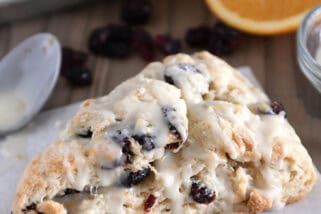

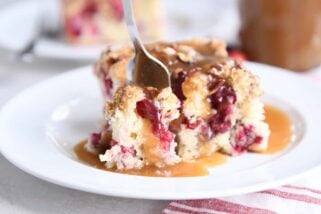
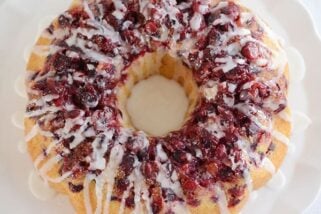
Such a delicious recipe! I doubled and baked in a bundt pan – perfect amount of batter for a cake size. I also bake the lemon and cranberry cake each year, and for the next Christmas party I will try the floured cranberries inside that cake as well as the ones on the top – extra pops of cranberries for the win.
This bread is really delicious. I love the juicy cranberries bursting with flavor. I think I’ll try a lemon version (replacing the orange) next. The bread reminds me of Kneaders cranberry bread but I think this one is better, and definitely more moist. Worth the effort!
Thanks for the comment, Michelle – really glad you liked this recipe!
If I make this with frozen cranberries, do I add them frozen or let them thaw? I’m assuming add them frozen as I think that is what I’ve done with similar recipes before…help!
Hi Jessica, Adding them frozen seems to work fine for smaller baked goods like muffins, but adding them frozen to this bread might make the inner crumb of the bread (surrounding the berries) a bit softer/soggier. For cranberries in this recipe, I’d thaw and pat dry before using.
Wow, this was really good! I had my doubts ( plus I had a half a bag of cranberries). I thought the berries would be too tart, but not so. We loved it! Easy to make, very tasty and even looks sort of festive to boot. Thanks, Mel !
Thanks for the review, Gary! Glad this bread exceeded your expectations. 🙂
These turned out so good! I followed the recipe exactly as written but I tripled it and made a large loaf, 2 mini loaves, and over a dozen muffins. They have been gobbled up by my teenagers(who thought they didn’t like cranberries) for snacks and breakfast. I also brought a plate of sliced bread to Thanksgiving and my extended family raved about how good it was!!
Loved reading this – thanks for taking the time to comment, Emily! Glad this bread was so well-loved!
You outdid yourself on this one, Mel!
Perfection!
Thank you so much, Amanda!
It’s yummy but my problem is that the bottom and sides were a bit overdone. I used dark pans and adjusted the oven to 325. Lightly greased pans with spray. Any ideas as to what I could change?
Hi Pam, dark-coated pans can be a bit tricky. Depending on how your oven bakes, you might need to decrease the oven temperature even more (maybe another 10-15 degrees) so the bread bakes fully without overbaking on the outside.
My wife made this and one issue but otherwise great. All of the cranberries floated to the very top during baking so the lower 3/4 of the loaf had no cranberries. I noticed in the pictures that cranberries were distributed throughout the loaf. Further information I noticed was in your introduction it says cranberries that don’t sink which I took to mean that they don’t fall to the bottom and remain suspended in the batter. Any ideas what happened?
Hi Richard, thanks for the comment. In answer to your question, I’m not entirely sure why that happened, but you/your wife can try pressing the cranberries into the batter once the batter is spread in the loaf pan(s). Sometimes the cranberries can concentrate in the upper third of the batter – so redistributing them in the loaf pan throughout the batter can help.
It is a cake, not bread !!!!!
I made this and it truly is the best cranberry orange bread I’ve ever had. Thank you so much for this recipe Mel! Don’t skip the glaze. I love cranberries and you’ll need the sweetness to balance out all the tartness in the berries that the cake has. I noticed the other reviews about using lemon juice instead of orange juice. I’m going to try that too! Happy Thanksgiving Mel!
Thank you so much for taking the time to let me know, Kristina! Happy Thanksgiving!
Huge hit! I made two loaves and my family devoured them! Thank you for sharing, Mel 😊
Tami, did you double the ingredients to make 2 loaves, or make two separate loaves? I’ve often wondered if doubling the ingredients would work out, since baking is a science.
Awesome, Tami! So happy to hear that!
When the recipe calls for “fresh” this means cranberries that are hard and not soft., correct,?
Also will the orange juice sweetened the bread to counter the tang of fresh cranberries?
Finally is it ok to freeze fresh berries for a later date? I ask since Safeway has a great sale on a quarr of fresh cranberrie so would like to use them for Christmas.
Hi John, yes, fresh cranberries can be frozen. They freeze really well! The orange juice helps sweeten the bread along with the sugar – the orange juice also adds flavor that compliments the cranberries. And yes, fresh cranberries should be firm and crunchy. Hope that helps!
Traveling for thanksgiving and wondering how long this bread will stay good for ? if i make it sunday and we eat it on wednesday ?
Hi Meghan – that timeline might be pushing it just a bit, but it does stay fresh-tasting for several days if kept chilled, so it’s worth a try.
The best cranberry orange loaf I’ve ever had , shred it with my Community Group
So, so happy to hear this, Deb – thank you!
Lovely bread. I used butter instead of the oil. Definitely going to make this again soon
Thanks for letting me know, Jessica!
You are the FIRST on-line baker who takes the time to mention the use of dark cookware AND the need to reduce baking temperature. This guarantees your recipes work since attention to detail is the hallmark of a good baker. I haven’t even baked the bread yet but am totally confident it will turn out superb. Will do so for the coming holidays.
Thanks, John! It’s an important note to keep in mind, especially for quick breads like this one! I hope you enjoy this bread if you try it!
It sounds like the berries are left whole. Is that right? In other recipes I have always had to cut each berry in half.
Thanks for your help. I’m so excited to try it!
Hi Linda – I leave the cranberries whole. I enjoy the bursting bites of cranberries in the bread, however, you could definitely cut the cranberries in half if you’d like. It really is just a matter of preference.
This is SO good! I don’t prefer orange in baked goods, so I used lemon instead and it was amazing! I’ll definitely make it the rest of the holiday season!
Thanks for the review, Becky! Glad you loved it with a lemon variation – I bet it was bright, punchy, and super yummy that way!
The bread is SO good! Everyone in my family loved it! Next time I’ll add a little more cranberries. I feel like there were a few slices that only had a few. Absolutely delicious! Thank you, Mel!
Thanks for letting me know, Aubrie! Glad you liked it!!
What do you think about adding chocolate chips instead of cranberries? I love chocolate and orange together.
Sounds like a great idea if you love that combo of flavors!
Hi Mel!
Made this today using 3 mini loaf pans – they took 31 minutes to bake in my oven. I used option 2 for icing and added about 3T of juice to get the right consistency. WOW! So much flavor packed in a little loaf! And the crunchy glaze is perfection. I will definitely make this again 🙂
Happy Thanksgiving and safe travels
Patricia
Patricia, yay! Thanks so much for taking the time to let me know. I love this bread baked in mini loaf pans, too, so I’m so happy it worked out well for you!
Could you use this batter to make muffins instead of the bread? Thanks! 🙂
That’s a great question – I haven’t tried it so I’m not 100% sure, but it should work pretty well!
I made it and it was delicious !!
Fantastic, Beverly! Thanks for letting me know!
Bursting with flavor indeed! I used clementine puree that I’d already made (cooked whole fruit and sugar, puréed) for the fresh zest. Outstanding! I might wanna cut the cranberries in half as the tart bites were quite tart. My husband was over the moon though! I think I undercooked it a bit as it sank just a touch as it cooled.
Thanks for the review, Jennifer – glad you enjoyed this. The clementine puree sounds incredible!
Not yet but I plan to make it for Thanksgiving and Christmas thank you!
Yes this is the best recipe for orange cranberry bread. Took it to book club today and everyone enjoyed and wanted the recipe. Loved it so moist and over the top flavor. Loved the cranberry tip worked wonderfully. Thank you for another home run. Btw if you have doTERRA wild orange adding in a few drops to both the bread and glaze really boosts the flavors. A great recipe to begin holiday baking the house smells so good.
That’s awesome this bread was such a hit with your book group. Thanks for letting me know that!! So glad you (and your friends) loved it!!
How much does the glaze contribute to the deliciousness of the bread itself? I need to avoid any extra sugar anyplace I can!
Hi Ann, you can leave the glaze off – the bread will obviously be less sweet and the orange flavor less pronounced.
TY! I’ll let you know the results.
I JUST bought oranges for something else and already had cranberries so you KNOW I had to make it. It’s delicious! My 13 yo said it’s the perfect level of tart between the oranges and cranberries and I agree! I’m taking the rest to book club and I’d be shocked if I don’t get compliments on how yummy it is! I always feel bad getting credit for your amazing recipes! 😆
Haha, Ali – take all the credit for yourself! I don’t need any. I’m just thrilled when I know recipes have become favorites! So happy you loved this bread. Thanks for making it so fast and taking the time to let me know!
I’d love to make mini loaves for co-workers… how much batter should I use for each pan?
Hi Shaynee, I didn’t measure the batter for each pan, but one batch of this recipe will fill three mini loaf pans with just the right amount if the pans are filled about 2/3 full.
Good morning, how would dried cranberries work in the recipe? Can’t wait to make the bread!
Hi Pam, I didn’t test using dried cranberries in this recipe as I wanted the bursting flavor of fresh cranberries – but you could experiment. The outcome obviously will be quite different than using fresh, but would maybe be similar to these cranberry orange scones? https://www.melskitchencafe.com/cranberry-orange-white-chocolate-scones/
I was thinking about this option, too, I thought I’d soak the cranberries in orange juice to plump them up a bit prior to mixing them in.
Mel, anyway I could roughly chop the cranberries? Not sure I want to bite into a whole cranberry as pretty as they look. It looks beautiful and delicious!
Yes, you can definitely rough chop them. In my test batches doing that, I didn’t love the results *quite* as much due to how the cranberries presented and distributed in the bread. However, it’s just a matter of preference so definitely go for it if you’d rather the cranberries in small pieces!
I am so excited to try this! Cranberry and orange are my absolute favorite and I cannot tell you how many times I’ve checked your site for this kind of muffin! Thank you, thank you! I will never buy the Krusteaz box mix again!
I hope you love it, Keri! Keep me posted if you try it!